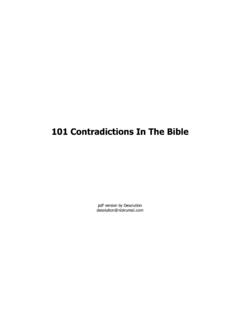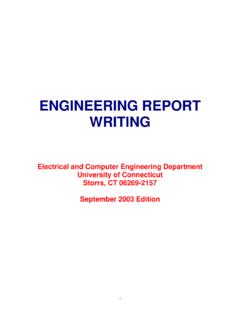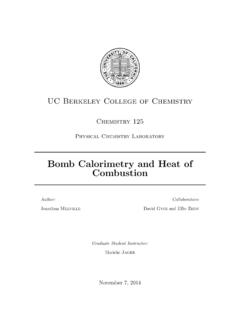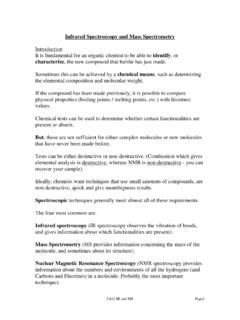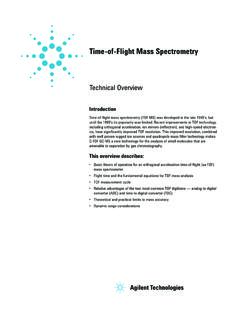Transcription of Matrix-Assisted Laser Desorption/Ionization (MALDI)
1 UC Berkeley College of ChemistryChemistry 105 Instrumental Methods in Analytical ChemistryMatrix- assisted LaserDesorption/ ionization ( maldi )Final PaperAuthor:JonathanMelvilleGraduate Student Instructors:RichardCooper& DanielMortensenMay 9, 2014 Contents1 Introduction12 Cocrystal Formation .. Laser Excitation, Ablation, and Analyte ionization .. mass spectrometry ..63 Proven Peptide mass Fingerprinting .. Polymer Molar mass Distribution ..94 Competition105 Outlook126 Conclusion12 Bibliography131 IntroductionMALDI, or Matrix-Assisted Laser Desorption/Ionization , is an analytical technique usedfor soft ionization ( ionization without fragmentation) of particles for use in mass spec-trometry, especially biopolymers or other macromolecules that are difficult to ionize with-out fragmentation.
2 By irradiating a sample with a high-energy (usually UV) Laser pulse,a plume of ions can be produced that can be analyzed (this is known as Laser Desorp-tion ionization ). maldi improves upon this process by greatly increasing the cutoff onanalyte mass , as well as providing a consistent crystal matrix that greatly increases theconsistency of results between Laser pulses[1].The technique was first described in a seminal paper by Karas et. al.[2], in which theauthors describe what they call Matrix-Assisted Laser Desorption for the first time:The mass spectrum of a mixture of alanine (Ala) and Trp taken at Trp thresh-old irradiance is shown in Figure 1. A strong signal of the Ala quasi-molecularion was observed in addition to that of Trp.
3 It is important to note that itsdesorption took place at an irradiance of about a tenth of that necessary forobtaining spectra of alanine thus must be regarded as an absorbing matrix resulting in molec-ular ion formation of the nonabsorbing alanine. This kind of matrix -assistedLD has also successfully been applied to reproducibly desorb other non-volatiles, , stachyose. (Karas, 1985)Figure 1: LD mass spectrum of a 1:1 mixture of alanine and tryptophan at 266 nm andthreshold irradiance for tryptophan. (Karas, 1985)1 Through the use of a 266 nm Nd-YAG pulsed Laser , Karas et. al. discovered thata mixture of alanine and tryptophan was more effective at producing alanine molecularions than a pure solution of alanine, and proposed that the tryptophan was absorbingthe Laser more effectively and transferring the energy to the a followup paper by the same authors, they determined that the use of a matrixfor Laser desorption mass spectrometry was extensible to much larger biomolecules, andwere characterized by high quasimolecular ion yield with little or no fragmentation andonly a few signals in the low mass range [3].
4 Most notably, Matrix-Assisted LD of mellitin(a polypeptide consisting of 26 amino acids, with a molecular mass of 2843 Da) producedthe mass spectrum seen in Figure 2, demonstrating the amazing capability of maldi toproduce molecular ions of biomacromolecules with minimal amounts of 2: matrix -LD spectra of mellitin/NicAc accumulated from 12 single Laser shots. (Karas, 1987)The first breakthrough in this method came in 1988, when Tanaka et. al.[4]detailedwhat they described as the ultra fine metal plus liquid matrix method , using 300 Acobalt nanoparticles in glycerol as a matrix for the sample, and using a 337 nm nitrogenlaser for ionization . A solution of the analyte would be mixed with this matrix solutionand vacuum dried, a process that increased molecular weight precision by about an orderof magnitude yet was one or two orders of magnitude faster to perform than competingmethods of the time (including sodium dodecyl sulfate poly-acrylamide gel electrophoresis(SDS-PAGE) and gel permeation chromatography (GPC)).
5 The authors supposed thatthis phenomenon was due to the unique qualities of the cobalt nanocrystals (low specific2heat, high photoabsorptivity, and large surface area per volume) that enhanced the speedof sample heating by the Laser , and thereby increased the rate of molecular ion formation,while the glycerol allowed for constant replenishment of unionized analyte molecules tothe location of Laser incidence. Through this method, Tanaka et. al. were consistentlyable to ionize lysozymes with molecular masses as high as 34,000 Da, and observed theproduction of ions ofm/z 100,000 the highest known at that time. In 2002, KoichiTanaka received the Nobel Prize in Chemistry, for [his] development of soft desorptionionisation methods for mass spectrometric analyses of biological macromolecules.
6 The technique began to come into its own with the discovery by Beavis and Chait[5]that cinnamic acid derivatives couple nicely with Nd-YAG or nitrogen UV lasers togreatly increase mass resolution, and to enable the determination of polypeptide molecu-lar weights with as little as one pmol of analyte. The cinnamic acid derivatives, includingnicotinic, ferulic, and caffeic acid, absorb the UV radiation strongly and subsequentlyenter the gas phase, producing an abundance of molecular ions with minimal fragment-ing. Cinnamic acid derivatives, such as -cyano-4-hydroxycinnamic acid, are still usedas choice matrix compounds today. Using modern techniques and instrumentation, theupper mass limit for maldi is around 350,000 Da, and in some cases requires as littleas 250 fmols of sample[6].
7 2 PrinciplesThe mechanism behind maldi relies on three principle steps. To begin with, a matrix -analyte solution must be prepared, and a cocrystal must be formed. This cocrystal isthen excited using a Laser to produce a plume of cocrystal particles that subsequentlyinteract to form molecular ions. Finally, the molecular ions are analyzed using a Cocrystal FormationThe first step of maldi requires the formation of a matrix -analyte cocrystal. A sam-ple of analyte is dissolved into a solution of the matrix compound and spotted onto aplate. The solvents then evaporate, producing a recrystallized matrix with interstitialanalyte particles; this substance is known as a cocrystal. Choice of matrix compoundis key to obtaining a quality spectrum: matrix compounds must fit a very specific setof criteria.
8 matrix compounds are generally low in mass , to ensure that they will easilyvaporize upon Laser incidence, though they must not be volatile enough to evaporatespontaneously. They must have high UV absorbance, which generally indicates the pres-ence of a conjugated system, because their sole purpose is to absorb radiation moreeffectively than the analyte molecules in order to transfer its energy to them. They aregenerally polar, to aid in the creation of an aqueous matrix -analyte solution, and areoften acidic, to act as a proton source for ionization of the 3: Cinnamic acid, of which many common matrix compounds are derivativesIt is immediately apparent from examining the structure of cinnamic acid (figure 3)why it is a common foundation for many matrix compounds.
9 It meets every necessarycharacteristic for an effective maldi matrix : relatively small size, conjugated system,polar functional group, and acidic proton.(a) Gentisic acid(b) Picolinic acid(c) Sinapic acidFigure 4: Some common matrix compounds for UV maldi -MSThe choice of matrix compound can greatly influence the capabilities of maldi , and4specific compounds can be chosen to increase the sensitivity of the method to particularanalytes. For example, gentisic acid (figure 4a) is particularly effective at detectingpeptides containing boronic acid groups[7], while picolinic acid matrixes (figure 4b) havebeen experimentally determined to effectively detect oligonucleotides[8], and sinapic acid(figure 4c) is considered a good matrix choice for peptides with masses in excess of 10,000Da[5].
10 Laser Excitation, Ablation, and Analyte IonizationThe next step involves the firing of a pulsed Laser at the matrix cocrystal. The Laser isgenerally a UV Laser ; common choices include a nitrogen Laser ( =337 nm) or a frequency-tripled Nd-YAG Laser ( =355 nm). The Laser vibrationally couples with the chromophoreof the matrix molecule, inducing a localized desorption of the matrix cocrystal and creat-ing a gaseous plume of matrix and analyte ions. The exact mechanism of this ablation isnot precisely known, but it is suspected to occur either because of sublimation after pho-tochemical excitation of matrix molecules or due to a sharp increase in pressure causedby rapid expansion of units in the crystal 5: The mechanism of maldi Laser incidenceIn the hot plume formed by the Laser , quasimolecular ions of the analyte molecule areformed.





